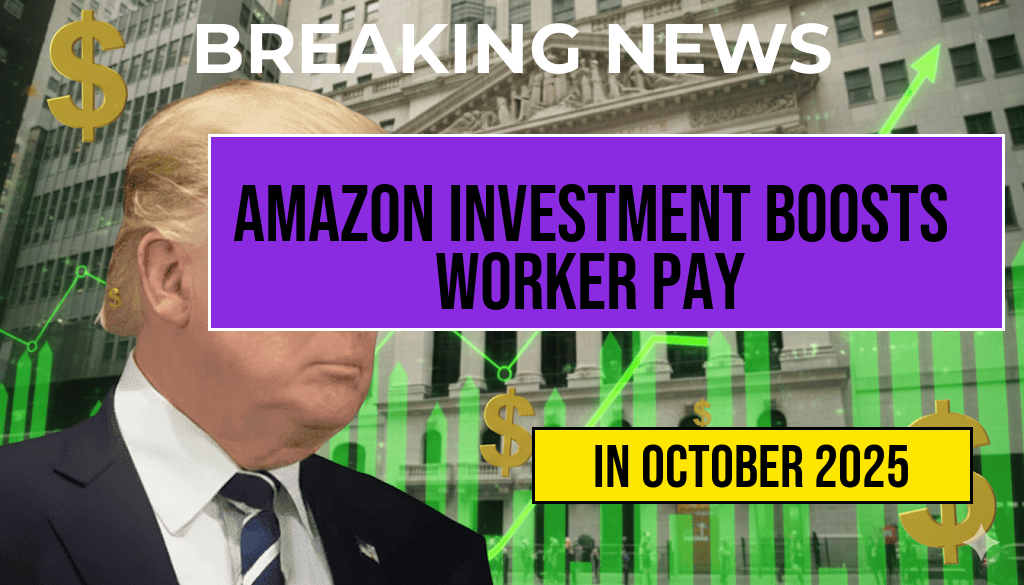Amazon’s recent $1 billion investment in its logistics and fulfillment infrastructure has triggered a significant shift in worker compensation across its fulfillment centers. According to company disclosures and labor reports, the average hourly pay for fulfillment workers has surged past $23 per hour nationwide—a notable increase from previous years. This move reflects Amazon’s intensified efforts to address workforce retention challenges amid a competitive labor market and rising operational costs. The investment, primarily directed toward expanding automation, upgrading facilities, and enhancing employee benefits, appears to be paying dividends in terms of improved wages. Industry analysts suggest that this wage growth could influence standard pay rates across the sector, prompting other e-commerce giants to reevaluate their compensation strategies. As Amazon continues to invest heavily in its fulfillment network, the ripple effects are expected to reshape the landscape of warehouse employment for years to come.
Impact of Amazon’s Investment on Fulfillment Worker Wages
Over the past year, Amazon has committed more than $1 billion toward modernizing its fulfillment infrastructure, including expanding existing warehouses and establishing new facilities across the United States. This strategic injection is part of a broader plan to increase capacity, improve delivery times, and maintain its competitive edge in the e-commerce sector. However, the investment has also directly influenced labor costs, leading to a substantial increase in average hourly wages for fulfillment workers.
Data compiled from Amazon’s quarterly labor reports indicates that the average hourly pay for fulfillment center employees has risen to approximately $23.50. This figure represents an increase of roughly 15% over the previous year and marks a significant shift in industry standards. Industry insiders point out that Amazon’s wage adjustments are not solely driven by the investment but also by mounting challenges in attracting and retaining skilled warehouse staff amid a tight labor market.
Details of the Wage Increase and Employee Benefits
| Component | Details |
|---|---|
| Base Hourly Wage | $22.00 – $25.00 (varies by location and role) |
| Signing Bonuses | Up to $3,000 in select regions |
| Performance Bonuses | Additional earnings linked to productivity metrics |
| Benefits | Health insurance, retirement plans, paid time off, employee discounts |
| Other Incentives | Tuition reimbursement, career development programs |
Sources within Amazon confirm that the company has increased its minimum pay rate at many fulfillment centers to $15 per hour, with the average now surpassing $23. The pay raise is complemented by enhancements in benefits, including comprehensive health coverage, paid leave, and educational assistance, designed to bolster worker satisfaction and reduce turnover.
Industry Response and Broader Market Trends
Amazon’s wage hike has prompted other major players in the logistics and retail sector to reconsider their compensation packages. Many competitors, such as Walmart and FedEx, have announced similar initiatives, citing industry-wide labor shortages and the need to retain skilled workers. According to Wikipedia’s logistics overview, tight labor markets are pushing wages upward across the supply chain, with fulfillment centers becoming increasingly competitive employment hubs.
Labor economists note that Amazon’s investment signals a potential shift toward more sustainable wages in warehousing roles, which have historically been characterized by low pay and limited upward mobility. The move could set a precedent for larger wage adjustments across the sector, especially as automation and AI continue to reshape operational workflows.
Worker Perspectives and Future Outlook
Many fulfillment workers have welcomed the wage increases, citing improved financial stability and greater job satisfaction. “The raise has made a real difference for my family,” says Maria Lopez, a warehouse associate in Dallas. “It feels like Amazon is finally recognizing the effort we put in.” Others express hope that the investment will lead to better working conditions and career advancement opportunities.
Looking ahead, industry analysts predict that Amazon’s ongoing investments will sustain wage growth and improve labor retention rates. However, some caution that the competitive landscape may lead to further increases, potentially impacting profit margins. As Amazon accelerates its automation initiatives, questions remain about how these technological advancements will influence employment levels and wages in the long term. Reports from Forbes highlight that automation could displace some roles, but also create new opportunities for tech-savvy workers within the fulfillment network.
Summary
- Amazon’s $1 billion investment has significantly boosted fulfillment worker wages, pushing the average hourly pay above $23.
- Enhanced benefits and incentives accompany the wage increase, aiming to improve retention and worker satisfaction.
- The move is influencing industry standards, prompting other companies to reevaluate their compensation strategies amid ongoing labor shortages.
- Workers report improved financial stability, with ongoing investments expected to shape employment conditions in logistics for the foreseeable future.
Frequently Asked Questions
What is the main focus of Amazon’s recent investment?
Amazon’s one billion dollar investment is primarily aimed at improving its fulfillment operations and increasing employee wages, resulting in average pay surpassing twenty-three dollars per hour.
How has Amazon’s investment affected fulfillment worker pay?
Following the significant investment, the average pay for fulfillment workers has surged above twenty-three dollars per hour, marking a substantial increase in wages.
What are the benefits for Amazon workers due to this investment?
Amazon workers are experiencing higher wages, which improve financial stability and job satisfaction, while the company aims to attract and retain more skilled employees.
Does this investment indicate Amazon’s commitment to improving working conditions?
Yes, the investment demonstrates Amazon’s commitment to enhancing employee compensation and strengthening its fulfillment network.
Are there any future plans for further investments or wage increases?
While specific future plans are not detailed, the recent investment suggests Amazon may continue to focus on wage growth and improving employee benefits as part of its ongoing strategy.










